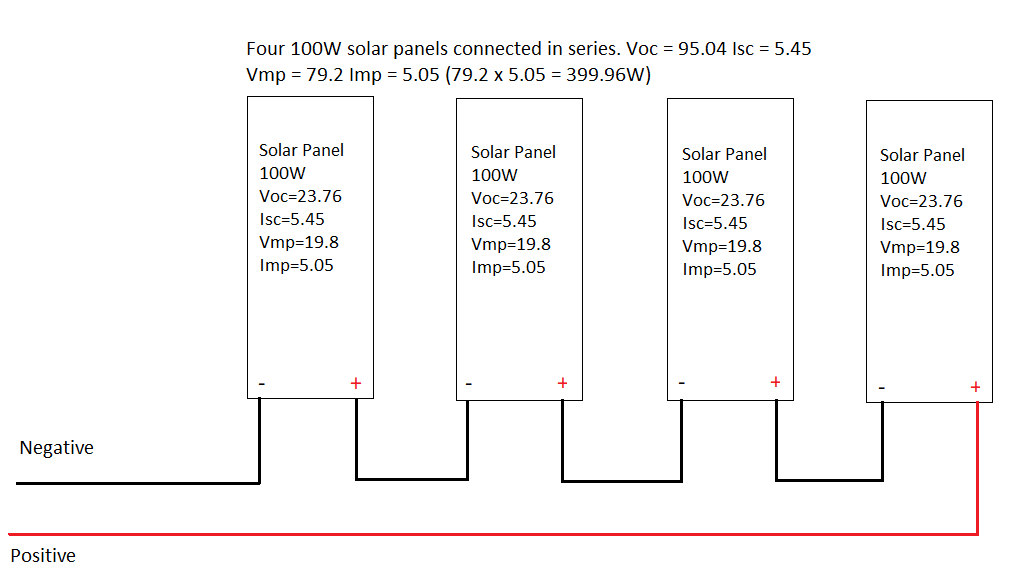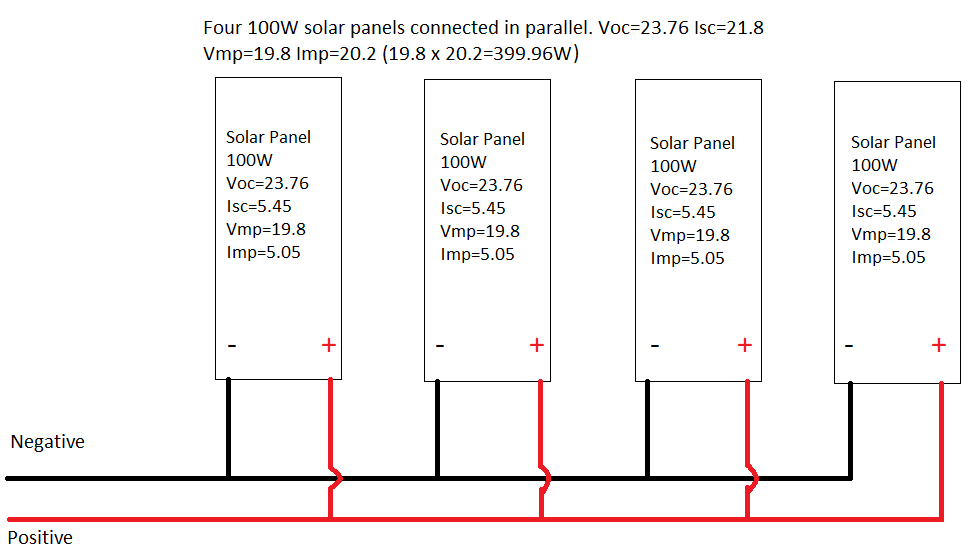In this information blog, we will try and help you understand how to connect solar panels together, in parallel or series, as both have very different outcomes regarding the voltage and current output from the solar panels. Several solar panels connected together is known as a PV array.
Please note: This blog is more technical than previous blogs but we will try and break it down.
Here we go
Before we start the technical bit you need to know the following:
Solar panels can be connected in series or parallel to increase voltage or current depending on the battery configuration charging requirements.
Connecting in series basically means you connect the panels together in a single line i.e. the positive of the first panel is connected to the negative of the next and so on. This increases the final voltage.
Connecting in parallel is where you have all the positives together from your solar panels connected as one to your controller and also all the negatives connected as one to your controller. This increases the final current.
We measure the solar panel output in Watts (W) or Watt hours (Wh), this is the amount of energy in Watts the solar panel can generate in an hour in standard test conditions (STC)
A point to note: No matter which way you connect your panels they won't give you any more than the rated power for that panel.
Technical / Mathematical bit
By connecting your panels in series or parallel you will keep the original Watt hour rating the same. So if four 100w panels are connected in series or in parallel the energy produced (Watts in this case 4 x 100w = 400w) will remain the same.
The Watt hour rating is a product of volts multiplied by amps (Vmp x Imp) on the solar panel data plate (normally found on the back of your solar panel) you will find the Vmp (Voltage maximum peak) and Imp (Current maximum peak) these figures are taken at STC (Standard test conditions) and once multiplied together will give you the watts of that panel.
You will also find on the data plate Voc (Voltage open circuit) and Isc (Current short circuit) the solar panel rating (Watts) cannot be calculated by multiplying Voc and Isc, these values are not generated in practical working conditions.
However we do used them when designing a system to understand what the max voltage, and current available from the solar panels could be when deciding what solar controller you will require.
Connections
The connection principle is the same as the connection of batteries wired for series or parallel.
The system voltage can be increased by connecting in series, the current production can be increased by connecting in parallel.
The charge controller you choose will need to be rated to tolerate higher voltages and currents depending on how you're looking at connecting them together.
As a general rule of thumb, all panels in the installation are best to be rated at the same voltage, wattage, and preferably the same brand as each other. Varying panels can be used, but unequal voltage and wattage ratings may lead to inefficient energy production and poor battery charging.
All cables and links need to be the same cross-sectional (CSA) area and length, and of a sufficient CSA to carry the current this will ensure that the circuit resistance, (Installation circuit impedance) and system losses will be kept to a minimum.
Solar Panels connected in Series
Fig 1 shows four solar panels connected in series; this will increase the system voltage. The solar panel Voc multiplied by the number of panels connected in series; this can be termed as a string voltage.
As can be seen in Fig 1, four solar panels with a Voc of 23.76 connected in series will give a system voltage of 95.04V (23.76 x 4) The current Isc will remain at 5.45

Fig.1 - Four solar panels connected in Series
Solar Panels connected in Parallel
Fig 2 shows the same four solar panels connected in parallel, this will multiply the amount of current produced.
Four solar panels with a Voc of 23.76 connected in parallel will give a system voltage of 23.76 (23.76 x 1) The current Isc will increase to 21.8 (5.45 x 4)

Fig.2 - Four solar panels connected in Parallel
Conclusion
So, I hear you ask, what is the best way for me to connect up my panels on the roof of my caravan/ motorhome/ boat etc.?
Well this all depends on many different things but the type of charge controller you have (yes we will do a blog on that one day) is the main reason to choose your connection method.
If you have an MPPT charge controller that can cope with the higher voltage, use the serial way to connect up your panels. If you have a PWM charge controller, it can't efficiently utilize the extra voltage so as long as it has a current rating that can cope with the extra current, use the parallel way to wire up your system.
Personally from my point of view the "series" way of connecting the panels is generally the best if you have an MPPT charge controller that can cope with the higher voltage.
What this means is the higher voltage of connected panels will keep your controller alive and charging the battery more often than not. I.e. the controller isn't hitting its low voltage point as early and shutting down the charging of the batteries.
If you have any questions about this blog or just want to understand more about solar panels, then contact us.
Kevin
